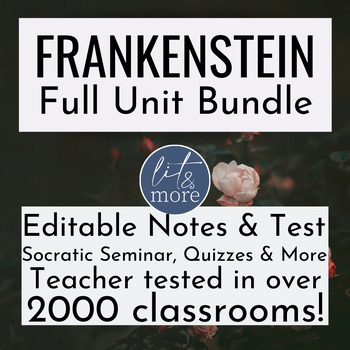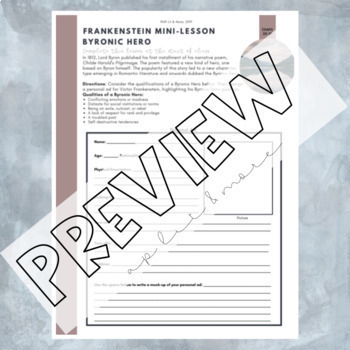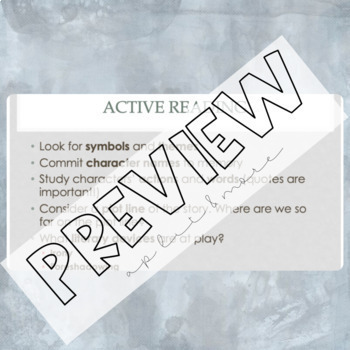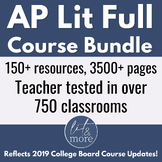Frankenstein Bundle | New AP English Literature Unit 6 Aligned | Grade 11 & 12
- Zip
What educators are saying
Products in this Bundle (7)
showing 1-5 of 7 products
Bonus
Also included in
- This AP English Literature Full Course Year Long bundle provides extensive materials for teaching AP Lit for an entire year. Perfect for both first year teachers and AP Literature teachers looking for a refresher. Teaching AP English Literature and Composition can seem to be an overwhelming endeavorPrice $375.00Original Price $601.25Save $226.25
Description
This Frankenstein Unit Bundle has recently been redesigned to meet the new AP English Literature course requirements, aligning with AP® English Literature Unit 6 (Longer Fiction or Drama Unit II). This three-week unit plan includes everything you would need to teach Mary Shelley's masterpiece, Frankenstein. Designed for an advanced placement course, it guides an analytical, quote-driven exploration of the text, along with multiple assessments and supplementary activities.
⭐ The following resources are included in this Frankenstein AP English Literature Bundle:
- An introduction to the text and background notes, including an engaging pre-test that compares the real Frankenstein with its pop culture references
- 133 pages of detailed, guided slideshow notes, guiding students through the reading with quotes, analysis, and thought-provoking questions
- A beautifully designed student note packet, with pre-reading homework, space for quote analysis, and notes on class discussions
- An answer key to all in-class discussion questions, so you'll never be puzzled by the notes
- 2 quizzes (Chapters 1-10 and Chapters 11-20) to be given during the course of the reading, + answer keys
- 1 Socratic Seminar, including thought-provoking questions, notes on the procedure, and a scoring rubric
- 3 on-demand writing prompts with both 6-point analytical and 9-point holistic scoring rubrics
- 1 unit test + answer key
- Unit objectives, guidelines, and suggested unit plan
- 4 analytical writing reflection prompts, to be given out during the course of student reading with suggested rubric
- 1 creative response project
- 1 text-based multiple choice quiz modeled after the AP exam, which could be given in the middle of the reading of the novel or as a summative assessment at the end of the reading
- Virtual teaching tools, including a Frankenstein hyperdoc (blending the notes and handouts), 2 Frankenstein quizzes, and Frankenstein test. These can be assigned through Google Classroom and other LMSs.
⭐ The notes' mini-lessons align with Unit 6 (Long Fiction or Drama Unit II) of the AP® Literature CED:
- CHR 1.A – Identify and describe what specific textual details reveal about a character, that character’s perspective, and that character’s motives.
- CHR 1.C – Explain the function of contrasting characters.
- CHR 1.E – Explain how a character’s own choices, actions, and speech reveal complexities in that character, and explain the function of those complexities.
- STR 3.A – Identify and describe how plot orders events in a narrative.
- STR 3.B – Explain the function of a particular sequence of events in a plot.
- STR 3.D – Explain the function of contrasts within a text.
- NAR 4.C – Identify and describe details, diction, or syntax in a text that reveal a narrator’s or speaker’s perspective.
- NAR 4.D – Explain how a narrator’s reliability affects a narrative.
- FIG 5.C – Identify and explain the function of a symbol.
⭐ How to use this Grade 11 & 12 Frankenstein AP English Literature Bundle:
- This unit could be used in any AP® English Literature class or scaled down (or just broadened out) for use in any 11-12 grade Literature class.
- The notes reflect the material from the 1831 edition of the book, but can be easily adapted for use with the 1818 version.
⭐ This resource is included in my AP®Lit Full Course Bundle!
⭐ If this is the perfect fit for your classroom, you will also love:
- How to Read Literature Like a Professor Unit for AP Lit
- Hamlet Unit Bundle
- Intro to Poetry Complete Unit - AP Lit Unit 2 Poetry I
⭐ Get free TpT credits for future purchases!
If you like this resource, then I’d love to hear from you! Select “My Purchases”, choose ratings and leave feedback and you will receive free credits to be used on your next TpT purchase.
⭐ Are you following Lit and More?
Be sure to follow my store for updates on my constantly growing range of literature resources.
Follow me on Instagram @litandmore for daily updates, suggestions, and strategies!
Visit my website here where you can read my blog, sign up for my email list to receive updates, freebies, giveaways, and exclusives!
AP® is a trademark registered by the College Board, which is not affiliated with, and does not endorse, this website.






